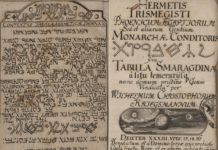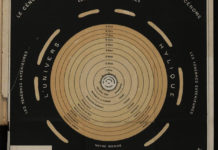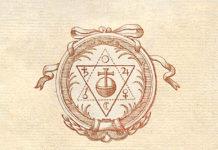Fully translated in English for the First Time
A notice on two Secret Societies in 1890
By Stanislas De Guaita
Source: Essais de Sciences Maudites 1: Au Seuil Du Mystere (1890)
Translated by Alex Bushman, 2018
Translator’s Note: This article by Stanislas de Guaita give some wonderful insight into the early development of Martinism at its inception and its relationship to the French Rosicrucian tradition. It also provides a glimpse into early Martinist practices, some of which have changed and some of which are still landmark components of the Martinist tradition.
Stanislas also gives a wonderfully concise distillation of the essence of his Rosicrucian tradition:
The Rose Croix is a society of action for the purpose of:
- Individual and reciprocal upliftment (Pansophia/Utopianism)
- Multiplication of the vital forces by reversibility (Trinosophia – Kabbalah/Alchemy/Magic)
- Revelation of Esoteric Christian Theology (Christophia)
There is much fruit to enjoy and seeds to gather in these few short pages. I hope you enjoy the wisdom imparted by one of our past masters as much as I did.
Sincerely,
Alex Bushman
The Martinist Fraternity and the Order of the Rose-Croix
Much has been written of Secret Societies; a lot and badly. I mean very inaccurately. It is no doubt that laborious researches have been accomplished; but political passion has mingled with it, and misfortune has wished, that, impatient to make a thesis conform to their preferences, the historiographers of these fraternities, for the most part, asked, in a jumble of documents accumulated by them, evidence of an opinion conceived in advance.
Besides, curious thing! Apart from the party tendencies, the subject has always been to exalt beyond measure and intoxicate the imagination of those who are more impartial. They are powerless to rationally sort out the materials they are overflowing in, to examine them with a torch of sound criticism, and finally to classify them according to their importance and authenticity. Far from deducing anything from the luminous, the typical and the peremptory, they drag themselves painfully through the labyrinth of the most hazardous conjectures, all burdensome of a badly digested erudition. As these hornets on a spree, drunk with contraband honey, buzz in place, wings quivering; they can no longer decide to take flight, due to having too generously foraged the ripe grapes.
As soon as it is about Secret Societies, it is remarkable that passion blinds the greatest number and that each one persists with delights, even against the obvious; Hence great confusion in ideas, and solutions which believe themselves absolute, in the most contradictory sense. Some writers, such as the constituent Mounier[1], do not recognize the very real and often decisive influence that these mysterious associations have had on the march of social and political events. Others, seeing in it (such as the esteemed author of the rest of the pamphlet of 1819) nothing but hives of conspirators and conventicles of more or less savage revolutionaries, call the rites of these fraternities an insignificant jugglery, and denounce their doctrines as deceiving the eye to use the naïve, or as a pretext to divert suspicion of established governments.
We must seek the truth between these two extreme opinions. The two are only partially correct; it is only a matter of understanding. A distinction is required first of all between the dogmatic Societies or educational societies, and the Societies of Propaganda or Action.
The order of the Unknown Philosophers, of which we have touched a few words on, could be taken as the first type; that of the Francs-Juges (Free Judges), which we have mentioned further under the name of Sainte-Vehme[2], would be suitable as the second type.
Others such as primitive Masonry, the ancient Rose-Croix and the Rose-Croix rénovée, proceed from both of these two classes. The Tombeau de Jacques Molay, by Cadet de Gassicourt, leaves no doubt about the double character of the old Masonry, an occult prolongation of the order of the Templars. We have elsewhere quite clearly clarified this decisive point. Whatever the case may be, it does not seem unwise to transcribe here the summary of the doctrines that Cadet de Gassicourt attributes to the Illuminés Théosophes, a general term in which it includes and confuses Martinists and dignitaries of the high grades of masonry.
We want the initiable reader to give his full attention: he will find condensed, in an equivocal, sometimes paradoxical or even apparently blasphemous form, many of the high mysteries of Occultism.
Theories of the Illuminated
God is not in space.
God himself is man and man is God.
The divine essence is love and wisdom.
Divine love and divine wisdom are substance and form.
The purpose of all creatures goes up by degrees, from the being most distant from man up to man; and from man to the Creator, the source of all[3].
God is the same in the smallest as in the greatest.
In the spiritual world, we see lands, waters, atmospheres, as in the natural world; but those of the first are spiritual and those of the second are material.
The Lord of all, Jehovah[4], could not create the Universe and all that it contains, without man.
There exists, in matter, a Force which tends to the production of the forms of beings.
All forms of the productions of nature present a kind of image of man.
All that is in the universe, considered as different beings, presents an image of man, and attests that God is man[5].
There are two faculties or principles, the Will and the Mind, created to be receptacles of the Lord.
The life of man is in his principle[6]s and his principles are in his brain.
The bodily life of man exists by the correspondence of the will with the heart, and of the understanding[7] with the lung[8].
This correspondence can reveal to us a number of things that are ignored, both concerning the will and the understanding, and on love and wisdom.
When one knows the correspondence of the heart with the will and that of the understanding with the lung, one will know what the soul of man is.
Wisdom or Mind[9] derives from the divine Love the power to exalt itself, to receive the light of Heaven and to understand what it manifests.
Divine love, purified by wisdom, in the understanding[10], becomes spiritual and heavenly.
But these generalities, important as they are, are beyond our scope.
Let the reader beware. For opening a commentary and transcribing the statement of these principles, whose scope is really important; for having attached some general observations, we have not pretended to cover here neither Secret Societies in general, nor their rites and their doctrines. Nevertheless, it is in favor of the distinction made above that it remains for us to specify, in a few rather firm terms, the purpose and organization of two occult societies in 1890.
Martinism is a purely initiatory group, a society of elementary teaching and diffusion of Esotericism. In the Rose-Croix we must see an order that is for both Education and Action.
Martinism is founded, like Masonry, on the occult Ternary, which is composed of three grades: the Affilié (1st degree) corresponds to the Apprentice mason; the Initié (2nd degree) corresponds to the Fellowcraft; the Initiateur (S ∴ I∴, 3rd degree) corresponds to Master.
However, as our brother Papus rightly points out “The instruction of a member of the first degree to that of an S ∴ I∴ far exceeds, from the traditional point of view, not only that of a Master, but that of a 33rd degree Freemason.”[11]
Also divided in three degrees, the Rose-Croix is grafted upon Martinism; for, to qualify for the first degree of the Rose-Croix, one must justify himself as a holder of the third Martinist degree ( S ∴ I∴). This is a formal condition of admission.
One can thus be an Initiator S ∴ I∴ without belonging to the order of the Rose-Croix; but I repeat, all affiliated Rose-Croix, even those of the first degree, have necessarily ascended the three martinist degrees.
The Martinist teachings focus on the principles of Esotericism and the synthesis of religions. Being elementary, they offer nothing that it is forbidden to divulge; only the basis of symbolism must be kept secret. We do not believe that we are breaking any oath by giving the public the following details.
The temple can be made in a simple room. When the layman is introduced, he finds himself surrounded by a certain number of masked men who point their unsheathed swords at his chest in silence. Wearing Egyptian styled bandelettes[12], they are dressed in some cases with a purple or scarlet robe, ample and flowing. The postulant is seated on a chair draped in white linen in front of an altar where a given number of luminaries shine, arranged in the prescribed order. They are usually tapered candles. Various emblematic objects in prefixed number (bronze sphinx, mask, dagger, skull with a flower, pantacles, etc …) rest, grouped according to the Ritual, on three overlapping cloths, of disparate colors. At the back of the room flames the Star of the Microcosm, the radiant Pentagram of the Holy Kabbalah. The recipient is questioned on the sequence of circumstances that led him to the threshold of occultism, and made him desire initiation. Then he is interrogated about God, Man and the Universe. Next he is interrogated on which one of these three objects which seems to interest him more, one then concludes as to his special aptitude for Metaphysics, or Psychology, or Natural Sciences, and the initiator, in his subsequent teachings, is careful to insist accordingly on proofs or arguments drawn from that of the three sciences which the neophyte seemed to prefer. However, as Liberty is a fundamental and absolute principle in the Order, the liberty of the layman is deemed inviolable. He is therefore free to refuse to answer all these questions. We only have the right to require one thing from him, the oath of silence in regards to the symbolism and also the name of his Initiator, the only one of all the assistants he is supposed to know. The teaching is finally transmitted to him, and all the present members consecrate him an Affiliate, Initiate or Initiator, as the case may be, by touching him lightly with their sword[13]. A synthetical speech usually closes the session, and one of the S ∴ I∴ quietly escorts the recipient back to the entrance.
When the postulant is known to have previously been instructed in the truths upon which the martinist program is based, the three degrees can be conferred upon him one after the other in a single session. This mode of initiation is called honorific title.
“No amount, however small, should be collected for the initiation. The layman knows only his initiator, and must cease all initiatory relation with him when he becomes an initiator in his turn. The Conscience is the sole judge of the acts of the Initiate, and no member has orders to receive from anyone[14]… Each Initiator instructs a group of members, who, becoming initiators in turn, give the movement a real importance.
The defect of the Martinist organization comes, in our opinion, from the absolute freedom left to each member of the Order. The result is a series of separate groups, which are individually very strongly constituted, but which must, at a given moment, be susceptible to reunite. This is what is being done right now.” (Papus, Sociétés d’Initiation, page 13)
These lines from our friend complete our indications and need no further comment. Let us add only that the Martinists are indebted to one of the great adepts of the Middle Ages, Fr. Jean Tritheim[15], for a stegonagraphic procedure which will allow one to accomplish at the desired time this meeting so desirable, this theosophical mobilization expected of all… In any case, they will always find in the Rose-Croix the element of synthesis and unity which they have missed for too long.
Indeed, if one of these associations claims the principles of unbridled freedom and individual initiative, the other is based entirely on the principles of collective authority and unitary Hierarchy. Martinism and the Rose-Croix constitute two complementary forces, in all the scientific scope of the term; may they never forget it!
The ancient Order of the Rose-Croix was about to die out three years ago, when two direct heirs of these august traditions resolved to renovate it, consolidating it on new foundations. The occult council of Twelve was reconstituted; the cadres of the second degree were quickly replenished. An outer circle was finally created, and now life flows freely in the mystical body of the rejuvenated colossus.
We have been permitted to provide here some excerpts of a constitution which until now has been a secret of the Renovated Rose-Croix.
In appearance (and externally), the Rose-Croix is a recognized and dogmatic Society, for the diffusion of occultism.
In reality (and internally), it is a secret society of action, for individual and reciprocal upliftment; the defense of its members; the multiplication of their vital forces by reversibility[16]; the ruin of the adepts of black magic; and finally, the struggle to reveal to Christian theology the esoteric magnificence of which it is unknowingly full of.
In short, it is a tree whose roots must draw their nutritive elements into the fertile soil of the 1st degree (Biology); in which the branches must flourish in scientific fraternity in the 2nd degree (Theory); And fructify in works in the 3rd degree (Practice).
In the nursery of the first degree, the Council of Twelve (3rd degree) choose the members of the second degree.
The members of the 2nd degree (a fortiori, if applicable, those of 3rd degree), organize conferences for the teaching of the members of the 1st degree, whose studies they must direct. But their main role is to carry out the instructions of the Council of Twelve.
The adepts of the 2nd degree are thus found straddling the wall that separates the Patent[17] from the Occult, the External from the Internal, and the open dogmatic Society from the Secret Society of Action.
Members of the 2nd degree have the right to address their wishes to the Twelve; but individually. Collectively, they cannot deliberate or make any conclusions about the instructions received from the Twelve.
Members of 2nd degree swear secrecy and must obey. Nevertheless they are free to withdraw by resigning. It is simply a matter of honoring the oaths of discretion, above all in regards to what they have known about our mysteries and our deliberations, including the very order that motivated their retirement.
The Twelve make decisions by unanimous vote, and the members of the 2nd degree execute the content. Only one of the Twelve, opposing with his formal VETO, is enough to push back a project and pass over it, without discussion, from the agenda pure and simple.
However (and this will remain secret among the Twelve) …. etc.
Such is the fragment of a Concordat hitherto known only to those who signed it; that is to say the members of the Council of Twelve, and the chiefs of the second degree. Both signed in one word, including the intials – in fraternitate R∴+∴ – is followed by the hieroglyph![]() .
.
The Council of Twelve consists of six known members and six unknown members. The role of the latter would be to rebuild the Order covertly, if any cause dissolves it.
The renovated Rose-Croix already has more than a thousand members.
New readers, don’t forget to sign up to our blog to read other more interesting articles just like this. We’ll never send you marketing emails. Just a quarterly update on the most recent top post. Sign up if you love this reading and Pansophers!
[1] De l’ Influence attribuée aux phisosophes, aux francs-maçons et aux illuminés sur la Révolution de France, by J. J. Mounier – Paris, 1822
[2] A.B. – Vehmic Court
[3] This is the complete main idea around which pivots the whole synthesis of Darwin. Let us note that from 1768, J.-B. Robinet published a very curious work under this title “Graduation naturelle des Formes de l’Etre ou Essais de la Nature qui apprend à faire l’homme”
[4] Refer to the note (2nd part of the Appendix) where we explain the identity, the essence of יהוה and הוה –אדם, of Jehovah and of Adam-Eve.
[5] The formulas are imperfect, often bad; but the Doctrine still shines under this garment unworthy of her.
[6] A.B. – Principe in French can also mean “origin or first cause”
[7] A. B. – Could also be translated as mind with the lung
[8] Let us not hasten too much shouting at the absurd!
[9] A.B. – Again, mind/understanding/reason can be used interchangeably in this linguistic context.
[10] A.B. – mind
[11] From the article “ Les Sociétés d’initiation en 1889”, by Papus (l’Initiation, n. 7, page 13)
[12] A.B. – I believe this is referring to an Egyptian styled head band, perhaps like a nemes
[13] Among these ceremonies, of which I have indicated the principal ones, only some are of strict obligation, the others are optional.
[14] As a Martinist
[15] A.B. – John Trithemius
[16] A.B. – A more rare use of the term réversibilité in French is: the quality of that which can be returned unto itself.
[17] A.B. – Patent in this case refers to the external, exoteric, visible – evident, obvious, recognized








